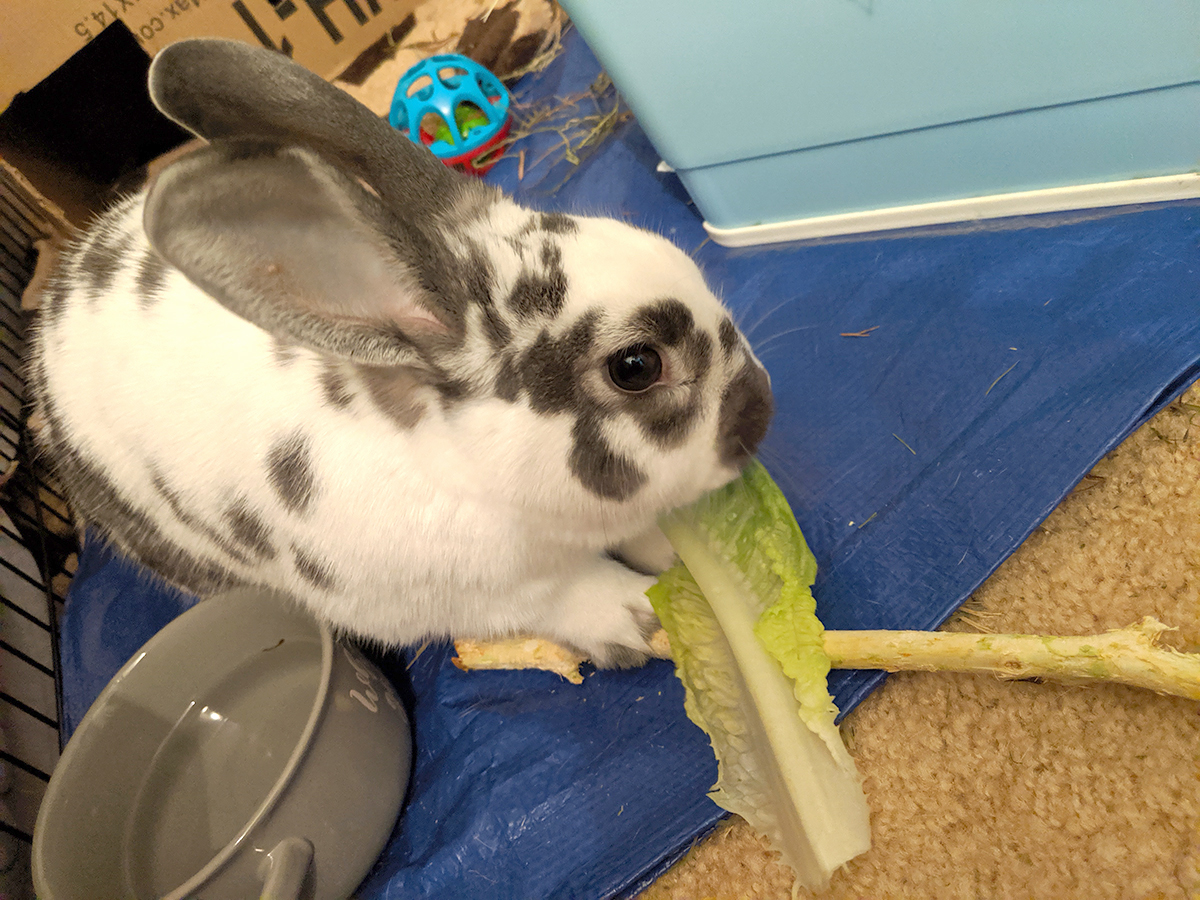Behavior
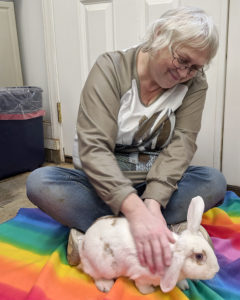 Each rabbit is an individual and has a unique personality. An important thing to remember is that rabbits are prey animals (unlike cats and dogs). Therefore, many rabbits do not like to be picked up and held, and may squirm or nip in order to get away. This does not mean that the rabbit does not like human attention, it may just prefer to cuddle up to you while having all four feet on the ground. Of course, some rabbits do enjoy being held and cuddled. When selecting a rabbit, personality is the most important thing to consider. One advantage to adopting a rescue rabbit is that the shelter volunteers know each rabbit’s personality and habits.
Each rabbit is an individual and has a unique personality. An important thing to remember is that rabbits are prey animals (unlike cats and dogs). Therefore, many rabbits do not like to be picked up and held, and may squirm or nip in order to get away. This does not mean that the rabbit does not like human attention, it may just prefer to cuddle up to you while having all four feet on the ground. Of course, some rabbits do enjoy being held and cuddled. When selecting a rabbit, personality is the most important thing to consider. One advantage to adopting a rescue rabbit is that the shelter volunteers know each rabbit’s personality and habits.
Housing
All EARS rabbits must be adopted as indoor pets. Rabbits who are kept outside are often exposed to cold, rain, snow, and predators. Also, because they are outside, they are usually out of mind, and do not get the attention they deserve. Rabbits make terrific indoor pets- they can be litter trained and they are very clean.
When shopping for a rabbit home, we recommend a large exercise pen or dog crate. We don’t recommend a rabbit cage or hutch as they do not give the rabbit enough room to run around and play. An exercise pen will give your rabbit plenty of room to move around, and are very easy to walk in and clean. A dog crate tends to have a large front door which provides easy access, and a tray on the bottom which can slide out, making cleaning easy. You can use newspaper or a fleece blanket to line a dog crate. Even if you plan to give your rabbits full range of your house, it is good for them to have a place to call their own.
Rabbits, like most pets, need room to exercise. If they are kept in a crate, they should also be given access to a large exercise pen or room(s) in the house for at least a few hours every day. Before giving a rabbit free roam of the house, it is important to bunny-proof: cover wires and block off areas that could be dangerous to the rabbit.
Essential items to set up a rabbit cage:
- Dog crate or exercise pen – somewhere the rabbit will be safe and comfortable, even when unsupervised
- Ceramic water bowl
- Ceramic food bowl
- Litter box- line with newspaper or litter (paper pulp), then fill with timothy hay
- Wooden toys or sticks (apple, willow, or untreated pine)
- Bedding- newspaper, fleece blanket, or paper pulp bedding (Carefresh), do NOT use wood chips as rabbit bedding as they are known to cause liver problems
Diet
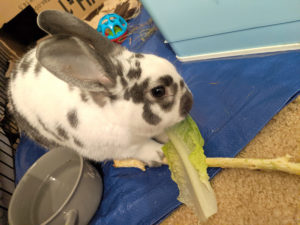 The largest portion of a rabbit’s diet is timothy hay; it should always be available for the rabbit to eat. We offer bags and bales of hay for a donation. If buying hay from a pet store, look for Oxbow timothy hay. It is usually less expensive to buy hay by the bale, but be sure to avoid farms that use pesticides.
The largest portion of a rabbit’s diet is timothy hay; it should always be available for the rabbit to eat. We offer bags and bales of hay for a donation. If buying hay from a pet store, look for Oxbow timothy hay. It is usually less expensive to buy hay by the bale, but be sure to avoid farms that use pesticides.
Timothy pellets should be given once or twice a day, but no more than 1/4 cup in a day (may vary according to the size of the rabbit). For young rabbits (under 6 months), we recommend Oxbow Young Rabbit Food. For adults, we recommend Oxbow Adult Rabbit Food or Kaytee Timothy Complete. You can get pellets from us for a donation, or from your local pet store or online.
A healthy diet also consists of fresh, leafy greens, such as: cilantro, romaine, spring greens, arugula, etc. Do NOT give iceberg lettuce, as it has no nutritional value and may be harmful to rabbits. A full list of greens is available at rabbit.org.
Grooming
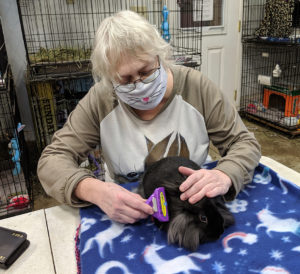 Rabbits are very clean animals; they groom themselves similarly to cats. Never bathe a rabbit, as they can die quickly from hypothermia. In cases where a rabbit cannot keep itself clean and sections of its fur become matted, then it is necessary to spot-clean the rabbit with a wash cloth and water (do not fully soak a rabbit with water).
Rabbits are very clean animals; they groom themselves similarly to cats. Never bathe a rabbit, as they can die quickly from hypothermia. In cases where a rabbit cannot keep itself clean and sections of its fur become matted, then it is necessary to spot-clean the rabbit with a wash cloth and water (do not fully soak a rabbit with water).
Some rabbits shed more than others, and most shed a large quantity of fur once or twice a year (molting). You should brush your rabbit frequently (once a day or once every two days) when he/she is molting. Even when not molting, it is important to regularly remove excess fur. Ideally, brush your rabbit at least once a week (long-haired breeds may require more frequent grooming). This can be done with a wire pet brush or thin-toothed plastic comb.
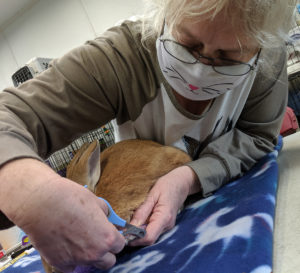 Rabbits have nails (or claws), five on each front paw and four on each back paw. They must be trimmed regularly to avoid over-growing. Rabbit nails can be trimmed using rabbit/cat nail trimming scissors. Rabbits usually do not tolerate nail files or human nail clippers. Trimming a rabbit’s nails is usually a two-person job- one person holds the rabbit while the other trims the nails. If your rabbit squirms a lot while being held, you can wrap him/her in a blanket, but avoid placing a rabbit on its back and into a trance (a trance is a high-stress state for rabbits). When trimming nails, be sure to note the extent of the quick (the bundle of nerves and blood vessels in the nail) in order to avoid cutting it. The quick is more difficult to see in darker nails, but it is possible by illuminating the nails with a flash light. Find the quick on each nail, and pinch around it with your fingers, then cut the nail distant to your fingers (this prevents you from accidentally hitting the quick). Trimming your rabbit’s nails can be intimidating, which is why we offer Bunny Spa Day every few months, where you can bring your rabbit to our shelter and we will cut their nails for you.
Rabbits have nails (or claws), five on each front paw and four on each back paw. They must be trimmed regularly to avoid over-growing. Rabbit nails can be trimmed using rabbit/cat nail trimming scissors. Rabbits usually do not tolerate nail files or human nail clippers. Trimming a rabbit’s nails is usually a two-person job- one person holds the rabbit while the other trims the nails. If your rabbit squirms a lot while being held, you can wrap him/her in a blanket, but avoid placing a rabbit on its back and into a trance (a trance is a high-stress state for rabbits). When trimming nails, be sure to note the extent of the quick (the bundle of nerves and blood vessels in the nail) in order to avoid cutting it. The quick is more difficult to see in darker nails, but it is possible by illuminating the nails with a flash light. Find the quick on each nail, and pinch around it with your fingers, then cut the nail distant to your fingers (this prevents you from accidentally hitting the quick). Trimming your rabbit’s nails can be intimidating, which is why we offer Bunny Spa Day every few months, where you can bring your rabbit to our shelter and we will cut their nails for you.
Health
The most important indicator of the health of a rabbit is its poop. A rabbit that is eating and pooping regularly is probably healthy. Rabbits have two types of poop: spherical, dry poop that they leave behind, and moist, berry-like cecotropes which they eat. Rabbits eat cecotropes as a part of their natural digestion, and they will almost never be seen.
If a rabbit stops eating and/or pooping, they must be taken to the vet, as this is a very serious sign. Rabbit poop that is abnormal in shape, color, or texture can be indicative of many conditions. This link is a comprehensive guide of different bunny poop and what it can mean (warning- there are images). Rabbits are adept at hiding illness (a defense mechanism due to being a prey animal), so any changes in your rabbit’s behavior could be due to illness. It is critical to recognize the warning signs early, and get your rabbit proper treatment.
Resources
Check out the House Rabbit Society site, a terrific resource for everything you need to know about house rabbits.
Howcast has a series of videos that do a great job of covering what you need to know, they are especially good for new rabbit adopters. Check them out!



